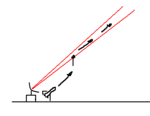Pretty much every source on the subject. Infrared guidance wasn't developed enough to be accurate. The MCLOS system mostly used could be easily jammed as with the Fritz-X guided bombs. The other guidance system was beam riding, which didn't succesfully work until the 50s with SAMs like Terrier. There were no German radar proximity fuses either, which would massively hinder any system.
Well some sources state differently
The effectiveness of a system like Fliergerfaust is questionable considering the lack of trials with the system.
Since the Wehrmacht ordered 10,000 sets plus 4 million projectiles in March 45, they might have been more convinced then you
You've got to be kidding. V2s were not radar guided. They were simple ballistic missiles with a primitive intertial guidance system. The CEP of the prototypes was 4.5km rising to 12km with acutal firings. The very few missiles fired with radar beam guidance managed a CEP of 2km. Please note that 2000 is a larger number than 20.
So what would be your translation for "Leitstrahl"?,Well it is Beam riding (along a Radar beam), were corrections were transmitted via radio control to sensors/receivers mounted on the fins of the V2.
It was designed in 1944 not 1940.
IIRC, Galland mentioned that he remembered projectiles being used during the Poland campaign and forwarded this in regards to the – within 9 month – developed R4M, so to me that sounds like there must have been a forerunner of the R4M, which would also explain the notable short time of development.
Regards
Kruska

